The fascinating story of aquarium snails is as delicious as algae! These multi-purpose misunderstood snails are more than their vibrant, yet unique exterior. They are popular amongst aquarists due to their beneficial and waste-cleaning instinctual nature.

Quick Sidenote: Do you want to watch this article instead of reading it? Checkout the highlight video below from our YouTube Channel (Or read the more detailed article below), be sure to Subscribe For More Great Fishkeeping Content:
The Benefits of Aquarium Snails:
Natural waste cleaners
Aquarium snails are known to be detritivores or “bottom feeders”, meaning they are scouring rocks, wood and plants for edible wastes that other creatures may have missed.
Having a waste cleaner helps to maintain cleanliness and reduces the growth of waste in your aquarium, which normally occurs over time.
Waste buildup can be detrimental because it can eventually lead to the pollution of harmful compounds like nitrates, nitrite, and ammonia in the water of the aquarium.
Algae Eaters
This benefit deserved its point. Algae, if not addressed, will grow uncontrolled and can even contaminate your aquarium water if in large enough quantities of specific variants. Most freshwater algae, however, aren’t harmful to fish in aquariums, but algal blooms are extremely unsightly. Good thing, these snails eat algae like it’s gourmet steak.
See Also: What Do Freshwater Aquarium Snails Eat? (+Tips), for more on feeding freshwater snails.
Natural plant fertilizers
What is captivating about this information is that this snail waste is the manure of the water, meaning their waste is a great fertilizer for aquarium plants. Their poop contains three main nutrients – nitrogen, phosphorus, and potassium that are needed for growing healthy plants!
They deserve their section in the Nat Geo Magazine
As mentioned previously, these vibrant colored uniquely engineered creatures hold a lasting impression on snail and non-snail enthusiasts. Their shells not only have intricate designs and textures but the shell shape and size add more novelty to their species.
To plant or not to plant?

Now that you have a good grasp on what aquarium snails are and the benefits of their eccentric existence, the next question is can they all be excellent planted pets? The answer is, it depends.
Sadly, but for good reason, some freshwater snails are considered pests by the majority of fishkeepers. So the real question should be, which aquarium snails provide less work in planted tanks?
Nerite Snails compatibility
These snails are well known to be the best algae eaters, making them great tank cleaners and filterers. However, the benefits list does not stop there. These species do not reproduce in freshwater which omits another concern of overpopulation. In essence, these snails require minimal upkeep.
Check out our article, What To Do with Unhatched Nerite Snail Eggs, for more information on nerite snail offspring.
Ramshorn snails compatibility
These snails are also known for their algae-eating ability, however, they can and will reproduce quickly; therefore more attention needs to be directed towards them if reproduction is one of your concerns.
Mystery Snail (Pomacea bridgesii) compatibility
These snails also make great tank habitat mates. They are generally safe with plants in the aquarium. The bigger their size the bigger the disclaimer. They also are considered algae eaters which is beneficial for maintaining the tank.
Check out our article, What To Do with Mystery Snail Eggs, for more information on mystery snail offspring.
What do I do if I have a snail that reproduces a lot?

You simply get rid of them… partially joking
On a serious note, there are some steps to ensure your tank’s homeostasis is maintained without any fret.
- This one is obvious, manual removal. For some, you may have your work cut out for you, but at least you can rest assured that it is common practice to technically purge the excess snails.
You can use your hands to remove them, or you can opt for using a small net or tweezers to gently pick the snails off plants and tank surfaces. While you do that, it is a good idea to look for any snail eggs to mitigate more reproduction. The characteristics of these snail eggs are jelly-like clusters on glass/decorations. - Limiting the amount of feeding is necessary. Whether that be for your fish in the tank who may not eat all that you feed it, causing the snails to have more food at the bottom; or cleaning up the algae and detritus yourself to limit their food supply.
An influx of food is the primary reason for snail overpopulation. But why is this a phenomenon? Because just like any other living being on this planet, food creates a favorable living condition.
When coupled with the right temperature and enough moisture, it increases the snails’ likelihood of reproducing. Just to clarify, food does not directly cause reproduction for snails, but merely gives them the energy and nutrients to increase the chance to. In essence, giving your snail uncomfortable living conditions to reduce reproduction is the aim. Is this animal cruelty? That is for you to answer (Don’t hurt your snails). - Introducing predatory fish – This one seems a bit cruel. Some fish abide by the food chain and help to regulate the snail population. To name a few, pufferfish, clown loaches, and certain cichlids will actively scout and eat snails.
- Lastly, chemical treatments are another option. Just be mindful that cautionary measures are needed as this can harm other inhabitants in the same tank as the targeted snails. Copper-based medications are effective at killing snails but can have a lasting detrimental impact on the tank’s ecosystem.
Mystery Snail also known as Ivory snails (Pomacea bridgesii)

These strikingly fascinating snails resembling “golden apples” were briefly introduced, but let’s do a deep dive into these common freshwater snails. Besides being another snail algae eater and a detritus devourer, these snails are known for their ease of care and fascinating behavior. A fun trick they can do is climb to the top of the tank and parachute down, a phenomenon the snail community calls “para-snailing”.
Mystery Snail Care:
- Aquarium pH- 7.6-8.4
- Hardness- On the hard side for their shells
- Water Temperature- 68-74 degrees Fahrenheit
- Lighting- Normal community tank lighting
Here are some key attributes of the Mystery Snail:
- Adult size- Can grow between 2-2.5 inches (5-6 cm) in diameter.
- Color pattern- Their body snail colors can range from yellow, gold, blue, green, brown, and purple.
- Lifespan- They can live between 1 to 3 years
- Unique Traits- They are expert “escape artists”. Meaning, they will take any opportunity to leave the tank. Another trait is their ability to use their gills, like fish, to breathe underwater. However, when the water gets dirty, these snails will cheekily extend a long tube called the siphon which allows them to breathe fresh air.
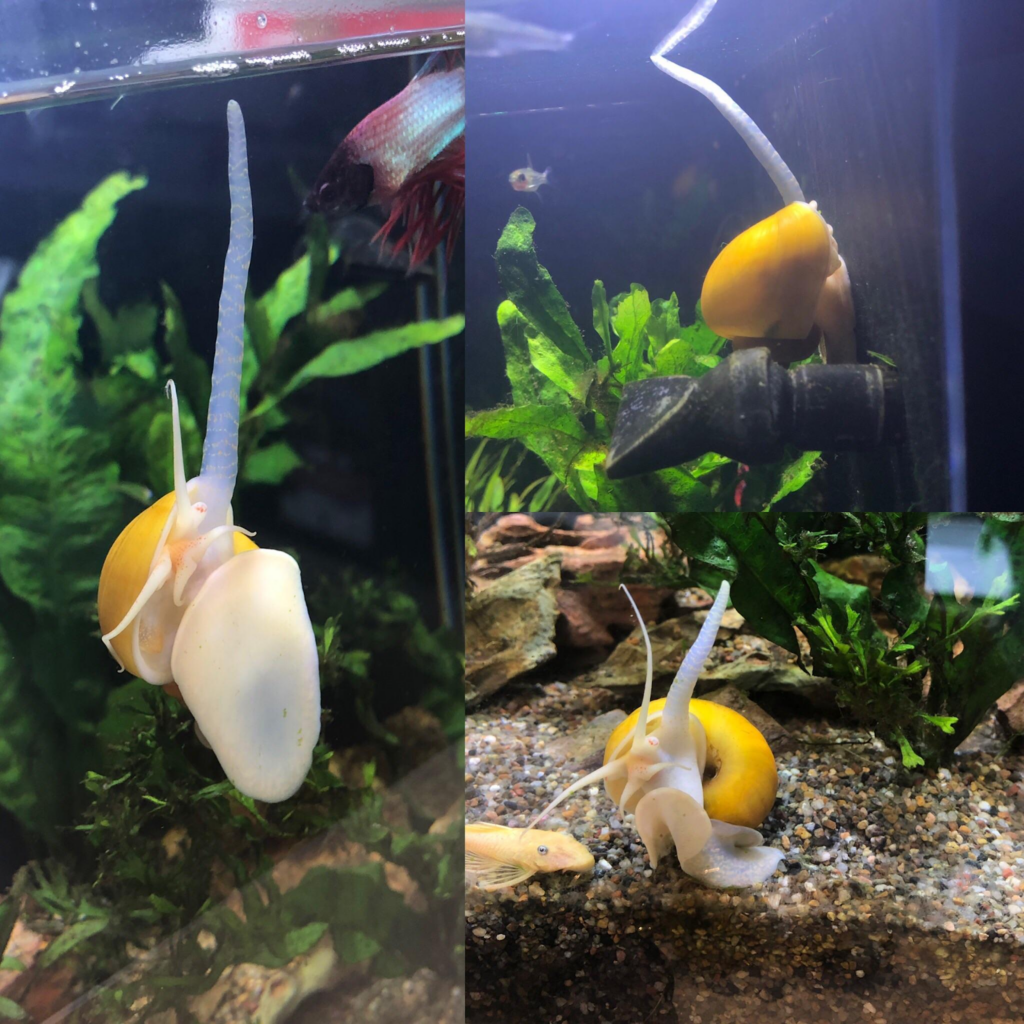
Ramshorn Snail
As previously mentioned, these distinctively coiled-shelled bustling creatures will need more attention for population control as their favorite activity is snail breeding. They are known to be excellent algae eaters, however, that can induce a favorable condition for them, causing quick multiplying. In the aquarist and hobbyist world, there is a divide regarding whether Ramshorn snails make great pets or pests.

Ramshorn Snail Care:
They are classified as fairly easy to care for, which makes them beginner-friendly pets or even pests depending on how you perceive them! These snails are resilient in various habitats, however, they prefer a tank with a variety of live plants. In terms of water parameters, they can also adapt to a range of water conditions.
- Aquarium pH- 7.0-7.5
- Hardness- On the hard side for their shells
- Water Temperature- 70-78 degrees Fahrenheit
- Lighting- Normal community tank lighting
Here are some key attributes of the Ramshorn Snail:
- Adult size- Can grow up to 1.5 inches in size.
- Color pattern- Their body snail colors can range from translucent, through various shades of brown to a dark, nearly black color.
- Lifespan- They can live to about one year
- Unique Traits- When they are young, their bodies can be seen as they are eating and digesting food due to their shell being thin and translucent.


Malaysian Trumpet Snail (Melanoides tuberculata)
They are easily identified by their elongated, conical shell with as many as 10 whorls. While they can make efficient scavengers and tank cleaners, thanks to their demanding appetite, they also are competing with Ramshorn on who can reproduce their species the most.

Malaysian Trumpet Snail Care:
The nature of these snails being debris eaters, makes feeding them less of a concern as they can make due with what they have. However, if you want to maintain the health of their hard shell, be mindful of giving them a calcium-rich diet.
- Aquarium pH- 7.0-7.5
- Water Temperature- 70-78 degrees Fahrenheit
- Lighting- Normal community tank lighting
Here are some key attributes of the Malaysian Trumpet Snail:
- Adult size- Can grow up to 1 inch in size.
- Color pattern- Their shell colors can range from brown, gray, and creamy-white.
- Lifespan- They can live for about one year. They can live longer depending on the condition and some luck. A dead Trumpet snail can be easily spotted if it is motionless at the bottom of the tank.
- Unique Traits- They are an added benefit of aerating and stirring the substrate.

Nerite Snails
They are famously known for their beautifully decorated zebra-like shell pattern which makes them hard to ignore. As previously mentioned, these snails are almost exclusively algae eaters.


Nerite Snail Care:
These snails are classified as low-maintenance as they can adapt to a range of water conditions and their appetite for algae. Additionally, they are conscious that they need a calcium-rich diet to maintain their healthy shell anatomy.
- Aquarium pH- 7.0-7.5
- Water Temperature- 72-78 degrees Fahrenheit
- Lighting- Normal community tank lighting
Here are some key attributes of the Nerite Snail:
- Adult size- Can grow between the size of a dime and a quarter. However, their sizes vary with their types.
- Color pattern/Nerite Snail patterns- Their shell colors can range from nearly black, dark brown, dark green, olive green, tan, golden, and reddish brown.

- Lifespan- They can live from 1-2 years, but are also known to die a week or so after being added to a tank.
- Unique Traits- They will never reproduce in freshwater.
Assassin Snail (Anentome Helena)
Now this snail species did not earn its name for nothing. They are known as carnivores who can be your very own natural pest control. Their reputation of being a population controller has made them popular pets to get the job done.

Assassin Snail Care:
These snails’ care is not too difficult, however, it is not as easy as other snail species. It is important to ensure that water temperatures are correct and consistent; Ensure they have food and enough for their appetite. When transporting an assassin snail to a tank, do so gently and slowly; ensuring that it maintains similar water temperatures from where you get them to their new home through acclimation.
- Aquarium pH- 7.0-8.0
- Water Temperature- 75-80 degrees Fahrenheit
- Hardness- Water should be hard to maintain its shell health and growth
- Lighting- Wide range acceptable
Here are some key attributes of the Assassin Snail:
- Adult size- Can grow about ¾ of an inch long. However, in the right conditions, they can grow up to a whopping 3 inches.
- Color pattern- Their shell colors vary in different colors, however, the most common is yellow and black or brown striping.
- Lifespan- They can live about 2 years. However, under the right conditions, they can live up to 5 years!
- Unique traits- They are the carnivorous aquarium snails that other snails would dread seeing.
Bladder Snail (Physa fontinalis)
This snail species are air-breathing freshwater snails that are characterized as small yellow-brown, sinistral shells with short blunt spires. They make excellent scavengers and cleaners for aquarium tanks. They consume a wide range of algae, making them a natural alternative for controlling algae growth.

Bladder Snail Care:
These snails consume algae, decaying plants, and leftover food from their tank mates therefore, can be low maintenance. They just need space in the tank for them to live comfortably.
- Aquarium pH- 6.8-7.2
- Water Temperature- 64-82 degrees Fahrenheit
- Hardness- Water should be at a moderate hardness level of (4-15 dGH).
- Lighting- Low light level because they are nocturnal snails
Here are some key attributes of the Bladder Snail:
- Adult size- Can grow to be about 1.5 cm in length and 0.9 cm in width
- Color pattern- They are normally light brown with a yellow-brown shell.
- Lifespan- They can live about 1 year. In an ideal environment, they live longer than that.
- Unique traits- They have transparent bodies, so you can observe their internal organs.
Rabbit Snail (Tylomelania Gemmifera)
These exotically looking snails are brightly colored have large snouts resembling an elephant’s and have two lengthy antennas that look like rabbit ears. This is where their nicknames (Rabbit Snail or Elephant Snail derive).

Rabbit Snail Care:
These snails prefer water temperatures on the warmer side. Hobbyists suggest keeping the tank on the hard side so that minerals are present for healthy shell growth.
- Aquarium pH- 7.2-7.5
- Water Temperature- 76-84 degrees Fahrenheit
- Hardness- Water should be hard to maintain its shell health and growth
- Lighting- Normal community lighting to semi-dim conditions
Here are some key attributes of the Rabbit Snail:
- Adult size- Can grow up to 3 inches long, while the Mini Rabbit Snail usually maxes out at 1.5 inches in length.
- Color pattern- They come in a variety of colors such as orange poso, golden, chocolate, and yellow.
- Lifespan- They can live up to 3 years or more in captivity.
- Unique traits- They are slow-breeding snails because they cannot reproduce asexually.
Apple Snail (Ampullariidae)
This snail’s name comes from one of their species being able to grow to be the size of an apple. These tropical and sub-tropical snails are unique in their appearance but also in their adaptation. They can handle periods of drought followed by periods of excessive rainfall.

Apple Snail Care:
These snails should be fed vegetables on a regular basis (lettuce, cucumber, carrots, etc). Ensure you clean the vegetables if you are unaware if they are free from insecticides. If the tap water in your area has copper or other metals ensure that you filter it as these snails are highly sensitive to these compounds.
- Aquarium pH- 7.2-8.0
- Water Temperature- 64-82 degrees Fahrenheit
- Hardness- Water should be hard.
- Lighting- Low light level because they are nocturnal snails
Here are some key attributes of the Apple Snail:
- Adult size- Can grow to be about 5.9 inches in diameter.
- Color pattern- They come in different colors like brown, albino, yellow, purple, pink, and jade.
- Lifespan- They can normally live up to 3 years in lower temperatures. In higher temperatures, they can live 5 years or more.
- Unique traits- They simultaneously have a gill and a lung as functional respiratory structures which allows them to be amphibious.
Great Pond Snail (Lymnaea stagnalis)
This snail species, native to the UK, is also known to be a scavenger as it will eat detritus, fish waste, dead plants, leftover fish food, dead fish, algae, and blanket weed. They are superior cleaners than most snails at the pet shop such as Nerite and Rabbit snails. These snails can survive the harshest temperatures in the UK, but can also adapt to tropical temperatures.

Great Pond Snail Care:
Ensure that these snails have a calcium-rich diet to maintain their shell health. Additionally, regularly clean out leftover food and exchange the water often. They are sensitive to copper and fish medication used to eradicate fish lice, anchor worms, and gill maggots.
- Aquarium pH- 7.0-8.0
- Water Temperature- 70-75 degrees Fahrenheit
- Hardness- Water should be hard.
- Lighting- Low light level because they are nocturnal snails
Here are some key attributes of the Great Pond Snail:
- Adult size- Can grow to be 6 cm in length, but 4 cm is the usual.
- Color pattern- They typically have a shiny yellowish-brown shell color.
- Lifespan- They can normally live up to 1 year but can exceed that if they are in the ideal living conditions.
- Unique traits- They are adaptable snails being able to live under various water conditions.
Japanese Trapdoor Snail
These snails have a reputation of being very tranquil and non-aggressive algae-eating pond snails. Due to their docile and peaceful personalities, they should be kept in tanks that are free from predators that can harm and kill them.

Japanese Trapdoor Snail Care:
They are adaptable to a wide range of water conditions, therefore keeping them in a tank with community tank parameters should not be a problem.
- Aquarium pH- 7.0-7.6
- Water Temperature- 72-80 degrees Fahrenheit
- Hardness- Water should be hard.
- Lighting- Regular community lighting is fine.
Here are some key attributes of the Japanese Trapdoor Snail:
Adult size- Can grow to be 6 cm in length, but 4 cm is the usual.
- Color pattern- They can come in various colors and shades like black, green, olive green, dark brown, reddish-brown, and light brown.
- Lifespan- They can live from 1-5 years and can exceed that if they are in ideal living conditions. However, it is common for these snails to die soon after being introduced to their new homes. This is often associated with the stress of being transported from the store to the shift in water in different tanks.
- Unique traits- They are adaptable coldwater aquarium snails being able to survive in cold water and temperatures of 0 degrees Fahrenheit.
[Colombian] Large Ramshorn Snail (Marisa cornuarietis)
These snails are different from the Ramshorn snails as they are larger in size and decorative in appearance. Despite their large size, they are considered peaceful freshwater snails who will not bother other tank inhabitants. They are also scavenger snails that will consume algae, biofilm, and leftover food.
![Pictured, a [Colombian] Large Ramshorn snail](https://aquanswers.com/wp-content/uploads/2024/11/image-75-1024x768.png)
[Colombian] Large Ramshorn Snail Care:
They are adaptable to a wide range of water conditions. The minimum tank they should be kept in is 20L for a small group. Ensure that you provide surfaces for them to climb and explore such as rocks, driftwood, and aquarium-safe decorations.
- Aquarium pH- 7.5-8.0
- Water Temperature- 71-84 degrees Fahrenheit
- Hardness- Water should be hard.
- Lighting- Regular community lighting is fine.
Here are some key attributes of the [Colombian] Large Ramshorn Snail:
- Adult size- Can grow to be 6 cm in length, but 4 cm is the usual.
- Color pattern- On the underside, they can be a light beige or yellow color. On the upper side, they have a contrasting shade of dark brown, sometimes with a reddish tint.
- Lifespan- They can live from 1-2 years.
- Unique traits- They possess both a lung and a gill as well as operculum which allows them to survive in waters with low levels of dissolved oxygen.
Spixi Snail (Asolene Spixi)
This striped aquarium snail is considered the rarest snail species by hobbyists. They are a type of apple snail known for their yellow shells with dark stripes. They are not named the best algae-eaters but they can eat pests like hydra.

Spixi Snail Care:
They are adaptable to a wide range of water conditions. Their snail care is not demanding, which is perfect for beginners and people keeping them just for a hobby. Just like any water creature, ensure the tank is set up correctly, and the water is properly cycled.
- Aquarium pH- 7.0-8.0
- Water Temperature- 75-82 degrees Fahrenheit
- Hardness- Water should be hard.
- Lighting- Dim-lit as they are nocturnal
Here are some key attributes of the Spixi Snail:
- Adult size- Can grow to be 1-1.2 inches)
- Color pattern- They are also known as zebra apple snails since they have cream to light yellow shells with dark spiral stripes and light, almost white bodies.
- Lifespan- They can live from 1-3 years.
- Unique traits- They rarely move during the day and mostly hide in the soil.
Tower Cap Snail (Brotia herculea)
This rare aquarium snail is uncommon, which adds a captivating allure to any aquarium tank. They have a conical shell with vibrant colors making them visually appealing. Their name derives from Hercules because of their sturdiness and tolerant nature.

Tower Cap Snail Care:
To keep a Tower Cap snail habitat, they require stable water conditions and perform regular water changes to keep them healthy.
- Aquarium pH- 7.0-8.0
- Water Temperature- 72-82 degrees Fahrenheit
- Hardness- Water should be hard.\
- Lighting- Dim-lit as they are nocturnal
Here are some key attributes of the Tower Cap Snail:
- Adult size- Can grow to be 2 inches in diameter. They do have a slow growth rate, taking several months for them to reach their full size.
- Color pattern- They can be hazel to dark brown
- Lifespan- They can live from 1-3 years.
- Unique traits- They are live-bearers, meaning the females give birth to fully-formed miniature snails.
Zebra Thorn Snail
These naturally tiny snails have black and yellow spiral patterns on their shells and small spikes that protrude from the front. They are known for eating algae off of plants, glass, and decorations; including green algae that can be difficult to remove. These snails will not breed in freshwater.

Zebra Thorn Snail Care:
They are almost exclusively known as the Algae-eating aquarium snail. They require a generous amount of algae as they are herbivores.
- Aquarium pH- 6.5-8.5
- Water Temperature- 65-85 degrees Fahrenheit
- Hardness- Water should be hard.
- Lighting- Can adapt to various lighting, however, if you are trying to breed them, they require minimal light.
Here are some key attributes of the Zebra Thorn Snail:
- Adult size- Can grow to be ¼-½ inch in diameter.
- Color pattern- They can be brown, green, and tan. Their most unique color variant is the black and yellow spiral.
- Unique traits- Their zebra-striped variant along with small spikes makes them visually amusing.
Conclusion
These aquarium freshwater snails have their benefits and cons. Most have similarities but are nuanced in their uniqueness. The variety of these snails alone makes it fun to learn which one would be a great pet whether you are a beginner or an enthusiast. The general benefit these snails provide is being algae-eaters and tank cleaners to a certain degree.
Choosing aquarium snails can be overwhelming, but it does not have to be daunting. Ensure that you choose the snail species that best fits your tank, setup, and maintenance goals. Keep in mind that whatever snail you choose, you follow their freshwater aquarium care.



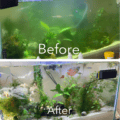
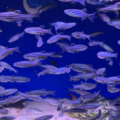



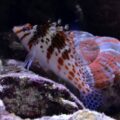

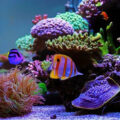
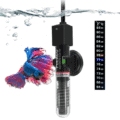
5 thoughts on “Discover 14 Popular Freshwater Snail Species for Your Aquarium”